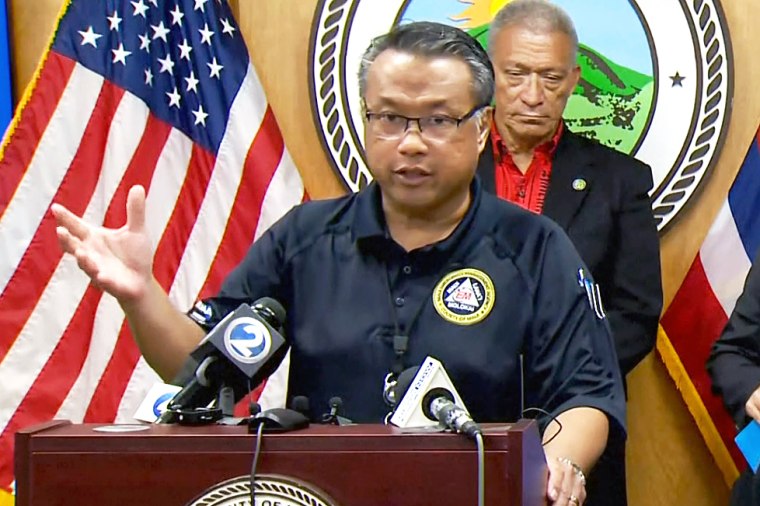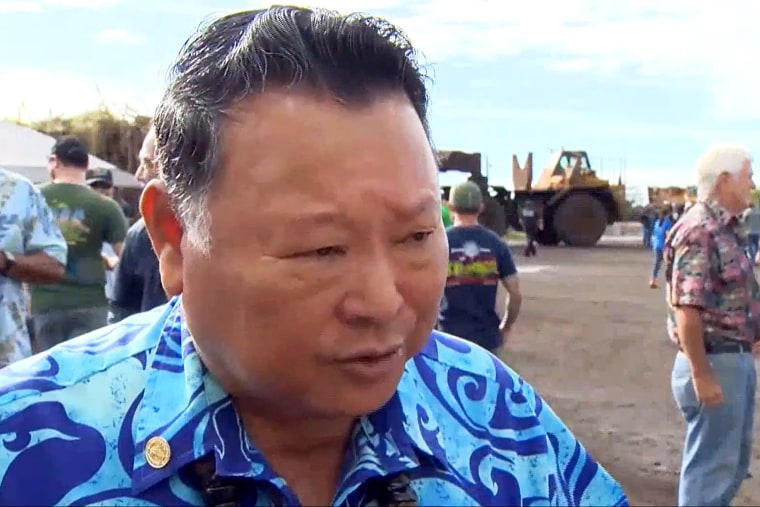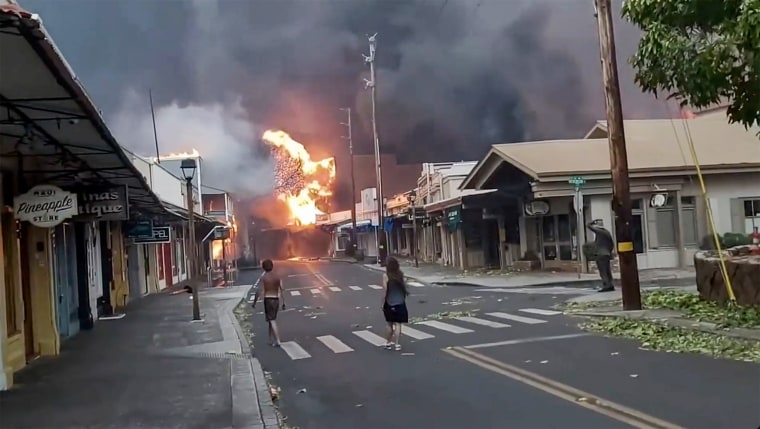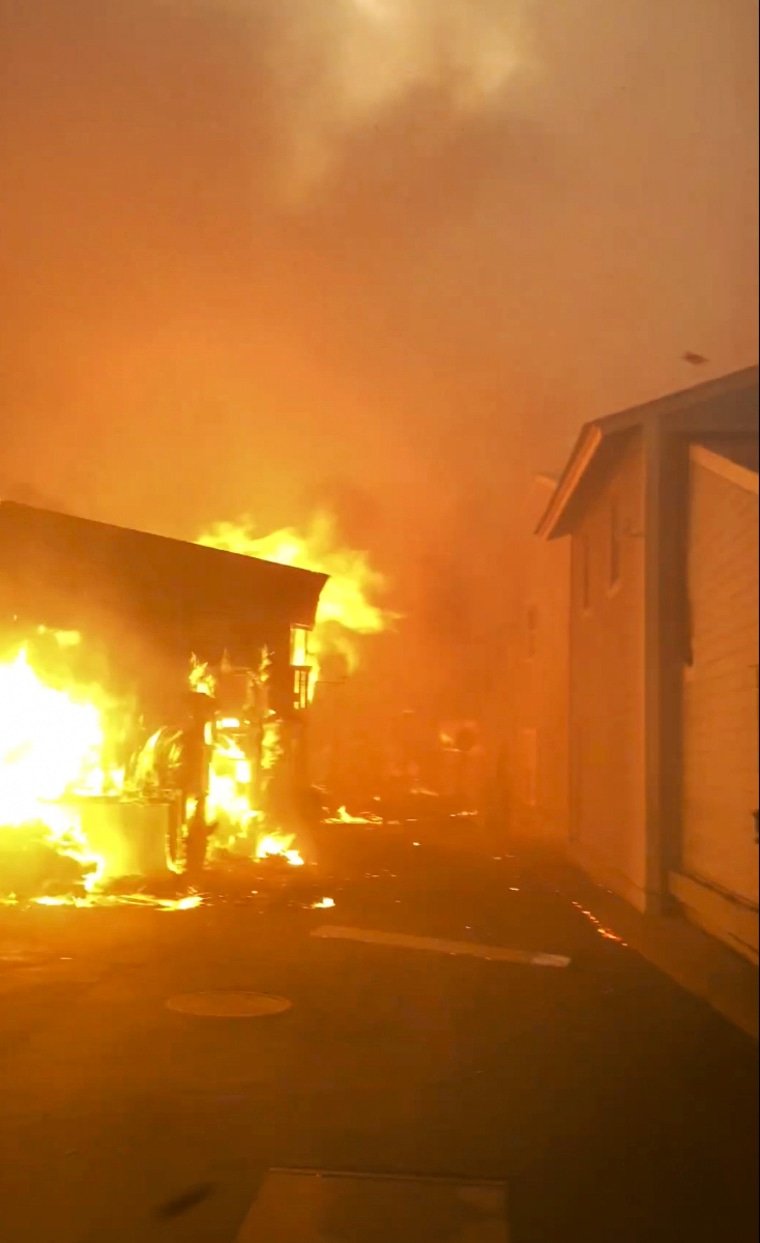
Five years ago, after tropical storm-force winds whipped sparks into towering walls of flames on the parched hillsides and fields above Lahaina, Maui’s top emergency management official at the time publicly expressed his relief that a far worse disaster had been averted.
At a special Maui County Council meeting held in the wake of the fires in 2018, Herman Andaya cited a combination of luck and heroics as the primary reasons advancing flames, stoked by gusts spun from Hurricane Lane offshore, stalled before they reached the historic town center.
“It nearly, nearly reached Lahaina Town,” he told council members at the Aug. 28, 2018, meeting, transcripts show. “And, had it jumped Lahainaluna Road, it would have been, I mean, it would have been devastating.”
Andaya, then in his first year as the county’s full-time emergency management director, went on to credit “the Police Department for acting very quickly and evacuating the people in the area” as critical for helping Lahaina to dodge potential catastrophe.
The near miss in 2018 claimed no lives, but the three separate wildfires collectively scorched more than 2,800 acres, devoured at least 21 structures, including 13 homes, and destroyed 30 vehicles — what was then the largest wildfire event in Maui history.
But in recent days, in the aftermath of what’s now America’s deadliest known wildfire, some Lahaina residents and at least one former county safety official view the fires of five years ago as a glaring missed opportunity.
This month, when another wildfire driven by nearby Hurricane Dora’s gusts swept down from the sunbaked hills and this time jumped Lahainaluna Road, the early evacuations in the town’s center, Lahaina Town — like those Andaya had praised — didn’t happen.
That key difference meant that when flames crossed the road this time, the fire rampaged through a town still teeming with residents and tourists. It destroyed more than 2,200 homes and businesses and has killed at least 115 people — a grim toll that steadily rises every day. More than 1,000 people remain unaccounted-for.
Despite the striking similarities in conditions surrounding the Lahaina fires of five years ago, emergency management and other public safety officials have left several primary concerns identified after the 2018 fires unaddressed, according to a review of records and interviews conducted by NBC News.
Officials also haven’t publicly released a county-commissioned after-action report to assess and recommend improvements to the 2018 emergency response, despite pleas by advocates and repeated requests by NBC News and other media organizations.

In fact, many of the concerns that are now blamed as contributors to this month’s deadly fire — from the failures to activate civil defense sirens to the inability to shut down power to transmission lines at risk during high winds — were raised as significant problems requiring attention after the fires five years ago.
“It was the exact same scenario in 2018,” said David Jung, a longtime tour boat captain and Lahaina resident, who five years ago publicly questioned why officials didn’t sound civil defense sirens as flames advanced toward town. “The only difference is that with the fire five years ago, the winds stopped at the very last minute. Call it an act of God or luck or whatever, but they had their second chance. They had five years to figure this out and fix it. Instead, nothing was done.”
Current and former Maui County officials, including current Mayor Richard Bissen, former Mayors Alan Arakawa and Mike Victorino, and Andaya, who resigned last week amid intense criticism for having failed to activate sirens in this month’s fire, didn’t immediately respond to requests for comment.
The state attorney general’s office said last week it will hire an independent investigator to review how local and state agencies responded to this month’s fire.
‘100% ignored’
After the 2018 fires, Jung voiced his complaints about the lack of sirens at a sometimes tense community meeting with Andaya, Arakawa and other officials at Lahainaluna High School, which had nearly been consumed by flames.
“We could have had a lot of deaths,” Arakawa told the crowd at the start of the meeting. “As it was, we had one major injury — one woman was burned — and no deaths.”
Considering the magnitude of the fire, the acreage it burned and how close it came to so many houses, he said, had it not been for the bravery of the people fighting the fire, “we could have lost most of Lahaina.”

Several residents who lost their homes took no issue with firefighters but identified a host of problems and demanded answers from the county officials, as well as state, utility and civil defense officials.
A video of the three-hour meeting shows that a resident inquired about the lack of a shutoff system for power lines. Others reported problems accessing water to help firefighting efforts and complained of failures to reduce overgrown brush and to better irrigate drought-prone fields. Some raised concerns about problems with evacuation routes, planning and communications, among other issues.
“We were given a bunch of lip service, and instead of preventing another fire, the focus of the meeting was ‘Look, we’re gonna give you guys money and reimburse you,’” Jung said. “And we were: ‘No, no, no, no, that is not what we want. You can give us all the money in the world; we just do not want this to happen again.’ But everything we told them was completely, 100% ignored.”
Jung, 72, said this week that while his house was destroyed, he escaped the Aug. 8 inferno on his catamaran, Kaulauna, in Lahaina Harbor as embers showered down on him.
He was lucky to get out alive, Jung said, noting that he happened to be at the marina when flames burst into Lahaina Town without warning. But he had no idea at the time whether his wife, Michelle, had escaped from their home on Front Street before flames consumed it. Just as they were five years earlier, he said, the island’s civil defense sirens were silent.
“It was all just a replay of 2018,” Jung said, “only worse.”

A primary difference between this month’s fire and those in 2018, according to Andaya’s public comments after both events, was the evacuation response.
After the fires five years ago, Andaya cited early evacuations of Lahaina Town residents as a key action to avert disaster. At a news conference last week about the recent fire, Andaya said that when Maui’s Emergency Operations Center learned flames were overrunning fire crews defending the town, “at that point we sent out the evacuation notices.”
Up until then, as the fire advanced toward town, Maui County had encouraged those in Lahaina Town, west of Lahainaluna Road, to stay put, records show.
“People on the west side are advised to shelter in place unless evacuations are ordered,” said an Aug. 8 update about the fire, posted on the county’s website at 4:45 p.m.
By that time, flames had breached Lahaina Town, some survivors have said.
Jung’s wife, Michelle, 61, said she only awoke from a nap that afternoon because a wind-whipped tree was beating against her window. The retired police officer managed to flee from her home in mismatched shoes, with her pet bird, Trouble, tucked under an arm, she said.
“No one had been evacuated. Nobody. No warning, no nothing,” she said.
As she and others ran through town, with flames erupting and buildings exploding behind them, Jung said she eventually “did see one cop car, who warned us to get the heck out of there,” she said. “But when we kept going, I never saw him or any others again. That was it.”

SeaRay Beltran, a former senior safety officer for Maui County who was in the Emergency Operations Center during the 2018 wildfire, said the timing of evacuations then compared with those during the fire this month were critical.
“When I was still there, we made a full evacuation,” Beltran said of the county’s 2018 response. “We had people out before the fire got to Lahaina.”
Beltran said officials made a mistake this time by ordering a partial evacuation and then standing down because they believed the fire had been contained.
The winds were so strong that officials should have been more cautious in case of a flare-up, Beltran said.
“Even if we made a mistake and the fire never got that far, you always want to be safe and sorry,” Beltran said.
The county’s 2020 hazard mitigation plan, which identifies all of Lahaina’s homes and buildings within a high-risk area for wildfire, warns that “populations with limited access to information may not receive time-critical warning information to enable them to reach places of safety.”
Beltran said officials should have planned to use sirens if communications were cut.
“Eventually, when the fire got really big, it burned down the power lines and cell towers. They could have sounded that alarm,” Beltran said. “Everybody knows once it jumps over the highway, you evacuate 100%. That didn’t happen.”
“I’m very angry,” he added. “People should not have died like that.”

 Latest Breaking News Online News Portal
Latest Breaking News Online News Portal




